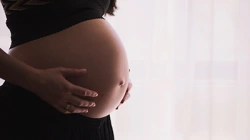.webp)
.webp)

Patryk Chodyniecki
Spondylolisthesis
- What is spondylolisthesis?
- Is spondylolisthesis the same as spondylolysis?
- What are the types of spondylolisthesis?
- How common is spondylolisthesis?
- Who is at risk of spondylolisthesis?
- Spondylolisthesis degrees
- Will I need spondylolisthesis surgery?
- What causes spondylolisthesis?
- Sensory disturbances in lower limbs and other symptoms
- How is spondylolisthesis diagnosed?
- Spondylolisthesis - Conservative treatment
- How do I know if I need surgery for spondylolisthesis?
- What is the treatment for spondylolisthesis?
- Spondylolisthesis - exercises and a healthy diet
- Spondylolisthesis - how to prevent recurrence?
- Prognosis after surgery for spondylolisthesis
Spondylolisthesis (or spondylolisthesis), also known as spinal cord disease, is a disease of the spine in which the vertebrae, together with the entire section of the higher vertebrae, move forward in relation to the vertebra located lower. In short, it is the displacement of the vertebrae of the spine relative to each other. Spinal exercises are the primary form of rehabilitation for minor conditions, while more serious conditions will require surgical treatment. What are the symptoms of spondylolisthesis and how to treat it? We write about it below!
What is spondylolisthesis?
Spondylolisthesis is a condition involving instability of the spine, which means that the vertebrae move more than they should. The vertebra slips out of place onto the vertebra below. It can put pressure on the nerve, which can cause lower back pain, leg pain, and decreased sensation in the lower limbs. The word spondylolisthesis comes from the Greek words "spondylos", which means "spine". or “vertebra”, a listhesis, meaning "sliding, sliding, or moving".
Is spondylolisthesis the same as spondylolysis?
Both spondylolysis and spondylolisthesis cause low back pain. These conditions are related, but they are not identical.
Spondylolysis: This spinal defect is a stress fracture or break in the bones of the spine. This is common in young athletes.
Spondylolisthesis: This condition occurs when a vertebra slips out of place, resting on the bone below.
Spondylolysis can cause spondylolisthesis when a stress fracture causes slippage, or a vertebra can slip out of place due to degenerative disease. The discs between the vertebrae and the facet joints (the two back parts of each vertebra that connect the vertebrae together) can wear out. The bone in the facet joints actually grows back and overgrows, causing an uneven and unstable surface that makes the vertebrae less able to stay in place.
Regardless of the cause, when a vertebra slips out of place, it puts pressure on the bone below. Most cases of spondylolisthesis do not cause symptoms. If you feel pain in your legs, it may also be due to pressure or pinching. nerve endings exiting the spinal canal (a tunnel formed by the interlocking vertebrae of the spine). The pressure or pinching is caused by the vertebrae slipping out and narrowing the space needed for the nerves.
What are the types of spondylolisthesis?
The types of spondylolisthesis are as follows:
- Congenital spondylolisthesis - occurs when a child's spine does not form as it should before birth. Misaligned vertebrae put a person at risk of slipping later in life.
- Isthmic spondylolisthesis - occurs as a result of spondylolysis. In this case, the crack or fracture weakens the bone.
- Degenerative spondylolisthesis - the most common type, occurs in older people. Over time, the discs that cushion the vertebrae lose water. Because the discs are thin, they are more likely to slip out of place
Less common types of spondylolisthesis include:
-
Traumatic spondylolisthesis - occurs when an injury causes the vertebrae to slip
-
Pathological spondylolisthesis - it is caused by a disease – such as osteoporosis, or tumor.
-
Postoperative spondylolisthesis - slipping as a result of spine surgery.
How common is spondylolisthesis?
Spondylolisthesis and spondylolysis occur in approximately 4% to 6% of the adult population. You can live with spondylolisthesis for years and not know it because there may be no symptoms.
Degenerative spondylolisthesis (occurring due to aging and wear and tear on the spine) is more common after age 50 and more common in women than men.
When back pain occurs in teenagers, isthmic spondylolisthesis (usually caused by spondylolysis) is one of the most common causes of the condition.
Who is at risk of spondylolisthesis?
You may be more susceptible to developing spondylolisthesis for the following reasons:
- Athletics: Young athletes (children and teenagers) who participate in sports that stretch the lumbar spine, such as gymnastics and soccer, are more susceptible to developing spondylolisthesis. Slippage of the vertebra tends to occur during children's growth spurts. Spondylolisthesis is one of the most common causes of back pain in teenagers.
- Genetics: Some people with isthmic spondylolisthesis are born with a thinner section of the vertebra called the pars interarticularis. This thin piece of bone connects the intervertebral joints, which connect the vertebrae directly above and below, creating a working unit that allows the spine to move. Thinner areas of the vertebrae are more susceptible to cracking and slipping. Degenerative spondylolisthesis also has a large genetic component.
- Age of the affected person: As people age, degenerative spine diseases can develop, which means that wear and tear on the spine weakens the vertebrae. Older adults with degenerative spine diseases may be at increased risk for spondylolisthesis. It becomes more common after the age of 50.
Spondylolisthesis degrees
To determine how severe spondylolisthesis is, your doctor will give you a grade:
- Low grade (grade I and grade II - minor displacement) usually does not require surgery. Low-grade cases are usually seen in adolescents with isthmic spondylolisthesis and in almost all cases of degenerative spondylolisthesis.
- High grade (Grade III and Grade IV) may require surgery if you are in a lot of pain.
Will I need spondylolisthesis surgery?
Your doctor will likely start with non-surgical options, such as rest and physical therapy, to help relax the muscles and stabilize the vertebrae or vertebral joints. This will strengthen your back and reduce spine instability. These treatments often relieve pain. Spondylolisthesis is diagnosed, among others, by magnetic resonance imaging.
Your doctor may recommend surgery if:
- you have high-grade spondylolisthesis
- you are experiencing severe pain.
- Non-surgical treatment does not bring improvement.
What causes spondylolisthesis?
Hyperextension of the spine is one of the main causes of spondylolisthesis in young athletes. Genetics may also play a role. Some people are born with a thinner spinal bone. In older adults, wear and tear of the spine and discs (pads between the vertebrae) can cause this condition.
Sensory disturbances in lower limbs and other symptoms
You may not experience any symptoms of spondylolisthesis. Some people have this disease and don't even know it. If you have symptoms, lower back pain is usually the main one. The pain may extend to the buttocks and thighs. You may also experience the following symptoms:
-
hamstring muscle spasms (muscles on the back of the thighs).
-
stiff back.
-
difficulty walking or standing for long periods of time.
-
pain when bending over.
-
numbness, weakness or tingling in the foot
How is spondylolisthesis diagnosed?
Your doctor will perform a physical examination and ask you about your symptoms. You will then likely need an imaging scan to confirm the diagnosis.
In this case, the following imaging tests can be performed:
-
Spine X-ray helps healthcare professionals check if a vertebra is out of place.
-
Computed tomography or MRI may be necessary to see more detail of the spine or soft tissue such as discs and nerves.
Spondylolisthesis - Conservative treatment
Non-surgical treatments include:
- Rest:Take a break from strenuous activities and sports.
- Medications: You can use over-the-counter non-steroidal anti-inflammatory drugs such as ibuprofen or naproxen as directed by your doctor. If this doesn't work, your doctor may prescribe other medications.
- Injections:You receive an injection of steroid drugs directly into the affected area.
- Physiotherapy:A physiotherapist can teach you targeted exercises to strengthen your abdomen and back. Daily exercise often relieves pain after a few weeks.
- Brace:An orthosis can help stabilize the spine. The brace limits movement so that fractures can heal. Harnesses are not used in adults.
How do I know if I need surgery for spondylolisthesis?
You may need surgery if you have high-grade spondylolisthesis, the pain is severe, or you have tried non-surgical treatments without success. The goal of spondylolisthesis surgery is to:
-
relieve the pain of an irritated nerve.
-
stabilize the spine where the vertebra has slipped.
-
Restore spine function.
What is the treatment for spondylolisthesis?
Back pain surgery for spondylolisthesis usually involvesspinal decompression, with or without fusion. Decompression alone is almost never performed in isthmic spondylolisthesis. Research shows that fusion with decompression can produce better results than decompression alone. During decompression surgery, the surgeon removes bone and disc from the spine. This procedure gives the nerves space inside the spinal canal, relieving pain.
Infusionsurgery, the surgeon fuses (connects) the two affected vertebrae. As they heal, they form one bone, eliminating movement between the two vertebrae. You may experience limited spine flexibility as a result of surgery.
Spondylolisthesis - exercises and a healthy diet
How to reduce the risk of developing a condition called spondylolisthesis? You can take these steps to reduce your risk of spondylolisthesis:
-
do regular exercises to build strong back and abdominal muscles
-
maintain a healthy weight. Being overweight puts additional strain on the lower back.
-
eat a well-balanced diet to keep your bones well-nourished and strong
Spondylolisthesis - how to prevent recurrence?
Your doctor may recommend exercises to strengthen the back and abdominal muscles, especially for children. Make sure you have regular check-ups so your doctor can detect any problems early. The chances of spondylolisthesis coming back or reoccurring are greater if the severity of the condition was assessed higher. For people with minor slippage, the condition may never return.
Prognosis after surgery for spondylolisthesis
Surgery has a high success rate. People who have undergone spondylolisthesis surgery often return to active life within a few months of surgery. You will probably need rehabilitation after surgery to get back to full fitness.
People with congenital defects of the vertebral joints or problems with the lower lumbar spine should see an orthopedist. Deformation of the spine, and especially deformation of the lumbar region, may lead to pain and problems with proper muscle tone. Dysplastic causes may have various causes. Let's remember to quickly implement treatment for spondylolisthesis, because thanks to exercises and changes in diet, we may be able to avoid surgical treatment.
www.nhs.uk/conditions/spondylolisthesis
www.cedars-sinai.org/health-library/diseases-and-conditions/s/spondylolisthesis.html
www.spine-health.com/conditions/spondylolisthesis/spondylolisthesis-treatment
https://kidshealth.org/en/parents/spondylolisthesis.html
Rate the text

Patryk Chodyniecki

























